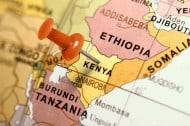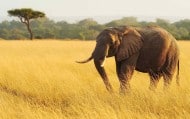
10 Interesting Facts About Kenya You Probably Didn’t Know
If you’re planning a trip to Kenya, you might already know it has more to offer than its famous coffee beans.
Over 60% of Kenya’s GDP comes from its service sector and most of that is tourism. That makes Kenya an attractive tourist destination. That’s no surprise when you consider the history, culture, and geography on offer in Kenya.
But there’s plenty about Kenya you might not know. To get you started, here are 10 interesting facts about Kenya.
1. It’s On the Equator
Pop quiz: where is the equator?
It’s a common misconception that the equator passes through northern Africa at the Sahara Desert. After all, that’s one of the hottest places on Earth, right?
In fact, the equator lines up with the divide between Africa’s bulbous northern section and its thinner, lower half. That means it runs right through Kenya.
When you visit Kenya, you have the chance to flit between the northern and southern hemispheres – even on the same safari tour. Like most places on the Equator, temperatures here are actually milder than in the tropics thanks to increased moisture in the air.
2. It Might Be Named For A Bird
The source of Kenya’s name is quite apparent. It takes its name from Mount Kenya, Kenya’s highest peak. But where did the mountain get its name?
It seems the locals gave the word that would become Kenya to German explorers when they asked the name of the mountain. The jury’s out on what the name means, but one popular theory is that it references the striped pattern of the male ostrich.
3. It Doesn’t Care About Gravity
Have you ever wanted to see something roll uphill? Kenya’s the place to go.
Kituluni Hill in Machakos county has a stretch where water flows uphill and cars roll upwards. It turns out that gravity isn’t as immutable as we think!
What’s really going on here? Kituluni Hill is a so-called gravity or magnetic hill. It’s a bizarre optical illusion in which a small downslope appears to be an upward slope due to the surrounding terrain.
4. It Has A Crying Stone
While we’re on the subject of spooky natural phenomena, let’s not forget Kenya’s Crying Stone.
This gigantic column of rock appears in the form of a figure in a long gown, with tears running down its entire body. Local people consider the Crying Stone a bringer of omens.
It’s not the most accessible of Kenya’s attractions due to poor roads, but it’s a unique wonder all the same.
5. It’s Coming Apart at the Seams
People always love to say that their country is falling apart, but Kenyans can say it in a literal sense.
Kenya’s Great Rift Valley is a perfect visual example of our world in motion. Formed by the movement of tectonic plates, the Great Rift Valley is around 6,000 kilometers in length.
As the tectonic plates continue to move away from each other, the Rift expands. In the far future, it might even mark the border of a brand new continent. Of course, Kenya will be long gone by then.

6. It Makes Coffee – For Everyone Else
Kenya is famously associated with coffee. It’s one of the USA’s favorite suppliers of coffee beans, and the Kenco brand, a household name in the UK, takes its name from its Kenyan founders.
The most surprising fact here is that Kenyans don’t drink much coffee.
While coffee is one of Kenya’s largest crops, it’s not often intended for local consumption. Instead, most of Kenya’s coffee ends up in other nations.
Kenyans prefer to drink tea and room temperature drinks. For some reason, widespread consumption of coffee never caught on, perhaps because it’s too valuable to consume.
7. Kenya’s National Animal is the Lion
Choosing a national animal isn’t always simple. Some nations, lacking any fearsome native creatures, have to make one up – hence the Welsh dragon. Others give up and choose something boring but native, like a rabbit.
Others, like Kenya, get lucky. Kenya’s lions make a suitable choice for a fearsome symbol of national pride.
It’s a sad reality that lions face extinction in Kenya, however. Their numbers hover at a paltry two thousand or so. It could soon be the case that the national Kenya animal is as fantastical as a dragon, after all.
8. It’s Ancient History
Kenya’s vibrant history begins much earlier than most people realize.
The Turkana Boy is the most complete example we have of an early human skeleton. He was of the species Homo erectus and lived a staggering 1.5-1/6 million years ago.
This fossil offers some compelling information about the evolution of the human race along with the anthropological history of Africa. Many details about the Turkana Boy are unknown, but he appears to have been only young when he died. Whatever his life story, he would’ve looked quite different from people today.
9. Its Wildebeests are a Wonder
A Kenya safari is a great chance to see some of the most incredible animals in the world. Most people know about the Big Five. But Kenya also features one of the Seven Natural Wonders of Africa.
The Wildebeest migration from Tanzania to Kenya stands alongside the Nile River and Mount Kilimanjaro is an African wonder. Over 2 million of these giant beasts make the long journey for greener pastures, accompanied by other grazers like the zebra.
10. It’s Poetry in Motion
Oral traditions formed the basis of human culture for thousands of years – even after we discovered writing. While many died out with the invention of the printing press, they’re still going strong in Kenya.
Poems and songs form a huge part of cultural events like marriages, and each cultural group in Kenya has its own favorite fables and histories.
When you’re in Kenya, make sure to listen in. You might discover some of mankind’s oldest stories, passed down from one generation to the next.
Kenya Believe These Facts About Kenya?
How many of these facts about Kenya did you know? We hope this Kenya fact file has encouraged you to learn about this rich and vibrant country.
Do you want to learn more about what Africa has on offer? Be sure to follow our blog.

